

|
| Elliott Sound Products | Project 27 |
 Please Note: PCBs are available for both power amp and preamp. Click the image for details.
Please Note: PCBs are available for both power amp and preamp. Click the image for details.Guitar amplifiers are always an interesting challenge. The tone controls, gain and overload characteristics are very individual, and the ideal combination varies from one guitarist to the next, and from one guitar to the next. There is no amp that satisfies everyone's requirements, and this offering is no exception. The preamp is now at Revision-A, and the complete schematic of the new version is shown below. The fundamental characteristics are not changed - it still has the same tone control 'stack' and other controls, but now has a second opamp to reduce output impedance and improve gain characteristics.
One major difference from any 'store bought' amplifier is that if you build it yourself, you can modify things to suit your own needs. The ability to experiment is the key to this circuit, which is although presented in complete form, there is every expectation that builders will make modifications to suit themselves. Of course there will be people who don't like the circuit (some without even trying it), and it is not intended to be the 'last word' - especially the preamp. There are many constructors who are very happy with it pretty much as shown, but there will always be people who are after something different. There's not much that limits the changes that you can make to the preamp to get the sound you want, but it is what it is - a 'solid state' preamp. Don't expect it to sound like a valve preamp, because it's not a valve preamp!
The power amp is rated at 100W into a 4Ω load, as this is typical of a 'combo' type amp with two 8Ω speakers in parallel. Alternatively, you can run the amp into a 'quad' box (4 x 8Ω speakers in series parallel - see Figure 5 in Project 27b, the original article) and will get about 60 Watts. For the really adventurous, 2 quad boxes and the amp head will provide 100W, but will be much louder than the twin. This is a common combination for guitarists, but it does make it hard for the sound guy to bring everything else up to the same level.
Note: This is a fully revised version of the original 100W guitar amp, and although there are a great many similarities, there are some substantial differences - so much so that a new version was warranted. This is (in part) because PCBs are available for both the power and preamp. The update was sufficiently substantial to warrant retaining the original version, although only the speaker box details have been retained - for these, see Project 27b.
Typical of the comments I get regularly about the P27 power and preamp combo is this e-mail from Tony ...
I'm delighted with the P27B/27 combination. It gives me the clear, punchy, uncluttered sound I've been looking for.
I've grown tired of whistles, bells and other embellishments that some anonymous guitar amp designer somewhere is telling me I've got to have. I've now got the sound I was hoping for. Love the Twin Reverb treble boost. Takes me back to 1960 !!
Without your module/boards and advice I'd have been playing about with breadboards for hours unsuccessfully searching for THE sound. Thanks.
This is just one of many, many e-mails I've received, but manages to sum up most of the comments in a couple of short sentences. This has been a popular project from the beginning, and is a solid and reliable performer that does not sacrifice sound or performance.
A photo of the Revision-A preamp is shown below. You'll see that there are two dual opamps. This is the main part of the Rev-A update - the output section now has gain (which is easily selected), and a better buffered low output impedance. The original circuit used an emitter-follower, but doesn't give the option for higher gain if required.

P27B Guitar Pre-Amplifier Board (Revision A)
The preamp circuit is shown in Figure 1, and has a few interesting characteristics that separate it from the 'normal' - assuming that there is such a thing. This is simple but elegant design, that provides excellent tonal range. The gain structure is designed to provide a huge amount of gain, which is ideal for those guitarists who like to get that fully distorted 'fat' sound. Not everyone will like the diode clipping circuit, and if that describes you, then leave it out (omit R14 and D1-D4, and replace R13 with a wire link). The effects loop is designed to allow you to use an external distortion unit.
With a couple of simple changes, the preamp can be tamed to suit just about any style of playing. Likewise, the tone controls as shown have sufficient range to cover almost anything from an electrified violin to a bass guitar - The response can be limited if you wish (by experimenting with the tone control capacitor values), but I suggest that you try it 'as is' before making any changes. (See below for more info.)
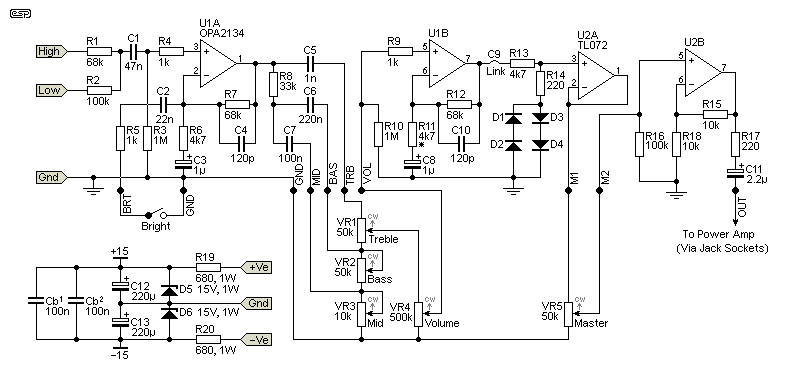
Figure 1 - Guitar Pre-Amplifier (P27B)
From Figure 1, you can see that the preamp uses two dual opamps. The last stage is a buffer with a gain of two, and maintains a low output impedance after the master volume control. The gain can be increased by reducing the value of R18, or reduced by increasing the value. As shown, with a typical guitar input, it is possible to get a very fat overdrive sound by winding up the volume, and then setting the master for a suitable level. The overall frequency response is deliberately limited to prevent extreme low-end waffle, and to cut the extreme highs to help reduce noise and to limit the response to the normal requirements for guitar. C9 is not used, and should be replaced with a link as shown.
If you use TL072 opamps, you may find that noise is a problem - especially at high gain with lots of treble boost. I strongly suggest that you use an OPA2134 - a premium audio opamp from Texas Instruments (Burr-Brown division), you will then find this quite possibly the quietest guitar amp you have ever heard (or not heard  ). At any gain setting, there is more pickup noise from my guitar than circuit noise. An even quieter opamp is the LM4562, and although it has bipolar transistor inputs, it should work well (although I've not tried it). Bipolar input opamps are less well suited to high impedances than JFET input types, and can be noisier than expected.
). At any gain setting, there is more pickup noise from my guitar than circuit noise. An even quieter opamp is the LM4562, and although it has bipolar transistor inputs, it should work well (although I've not tried it). Bipolar input opamps are less well suited to high impedances than JFET input types, and can be noisier than expected.
Notes:
1 - IC pinouts are industry standard for dual opamps - pin 4 is -ve supply, and pin 8 is +ve supply.
2 - Opamp supply pins must be bypassed to earth with 100nF caps (preferably ceramic) as close as possible to the opamp itself.
3 - Diodes are 1N4148, 1N914 or similar.
4 - Pots should be linear for tone controls, and log for volume and master.
The power supply section (bottom left corner) connects directly to the main +/-35V power amp supply. Use 1 Watt zener diodes (D5 and D6), and make sure that the zener supply resistors (R19 and R20, 680Ω 1 Watt) are kept away from other components, as they will get quite warm in operation. The preamp PCB accommodates the supply on the board.
The pin connections shown (either large dots or 'port' symbols) are the pins from the PCB. Normally, all pots would be PCB types, and mounted directly to the board. For a DIY project, that would limit the layout to that imposed by the board, so all connections use wiring. It may look a bit hard, but is quite simple and looks fine when the unit is completed. Cable ties keep the wiring neat, and only a single connection to the GND point should be used (several are provided, so choose one that suits your layout.
If you don't need all the gain that is available, simply increase the value of R6 (the first 4k7 resistor) - for even less noise and gain, increase R11 (the second 4k7) as well. For more gain, decrease R11 - I suggest a minimum of 2k2 here.
If the bright switch is too bright (too much treble), increase the 1k resistor (R5) to tame it down again. Reduce the value to get more bite. The tone control arrangement shown will give zero output if all controls are set to minimum - this is unlikely to be a common requirement in use, but be aware of it when testing.
The diode network at the output is designed to allow the preamp to generate a 'soft' clipping characteristic when the volume is turned up. Because of the diode clipping, the power amp needs to have an input sensitivity of about 750mV for full output, otherwise it will not be possible to get full power even with the Master gain control at the maximum setting.
Make sure that the input connectors are isolated from the chassis. The earth isolation components in the power supply help to prevent hum (especially when the amp is connected to other mains powered equipment).
If problems are encountered with this circuit, then you have made a wiring mistake ... period. A golden rule here is to check the wiring, then keep on checking it until you find the error, since I can assure you that if it does not work properly there is at least one mistake, and probably more.
The input, effects and output connections are shown in Figure 1B.
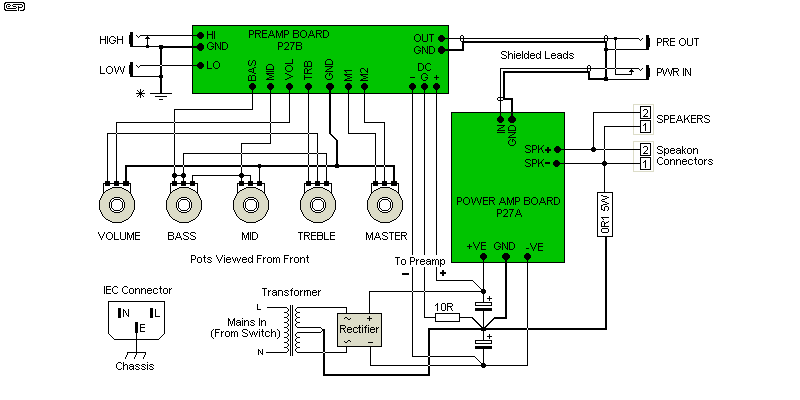
Figure 1B - Internal Wiring
The connections shown are very similar (ok, virtually identical  ) to those used in my prototype. Noise is extremely low, and probably could have been lower if I had made the amp a little bigger. All connectors must be fully insulated types, so there is no connection to chassis. This is very important !
) to those used in my prototype. Noise is extremely low, and probably could have been lower if I had made the amp a little bigger. All connectors must be fully insulated types, so there is no connection to chassis. This is very important !
You will see from the above diagram that I did not include the 'loop breaker' circuit shown in the power supply diagram. For my needs, it is not required, for your needs, I shall let you decide. If you choose to use it, then the earth (chassis) connection marked * (next to the input connectors) must be left off.

Potentiometer Wiring
Because the pot wiring can be confusing, the connections are shown above viewed from the rear, with colour-coding so each connection can be traces easily. Once the wires for the tone and volume pots are in place, there are only four wires (excluding 'Bright' and ground) that you need to worry about. These connect to the PCB with the PCB termination names reproduced above (i.e. Vol, Bas, Mid and Treb). The view is from the rear of the pots, just as you'll see them when running the interconnections. This should make wiring the pots much less stressful.
A few important points ...
As shown, the preamp is just as usable for bass or electric piano as for rhythm or lead guitar. The main change that you may consider is to delete the clipping diodes (unless fuzz bass/piano is something you want, of course). Delete R14, and D1-D4, but the remainder of the circuit is ideally unchanged.
You may also want to experiment with the tone control caps - I shall leave it to the builder to decide what to change, based on listening tests. C3 and C8 may be increased to 4.7µF to provide an extended bass response. If the gain is too high, simply increase R11 (10k would be a good starting point and will halve the gain).
The power amp board has remained unchanged since it was first published in 2002. It certainly isn't broken, so there's no reason to fix it. The photo below shows a fully assembled board (available as shown as M27). Using TIP35/36C transistors, the output stage is deliberately massive overkill. This ensures reliability under the most arduous stage conditions. No amplifier can be made immune from everything, but this does come close.
In the photo, you can also see the two clamps that are used to hold the PCB to the heatsink. You can use anything similar, or simply use two short (about 30mm) lengths of square section steel or aluminium. Make sure that you allow clearance for the wirewound resistors (R20, R21). I suggest that a 4mm machine screw be used if possible, but 3mm screws also work just fine provided you don't over-tighten them (they may break, and can be very difficult to remove if that happens).
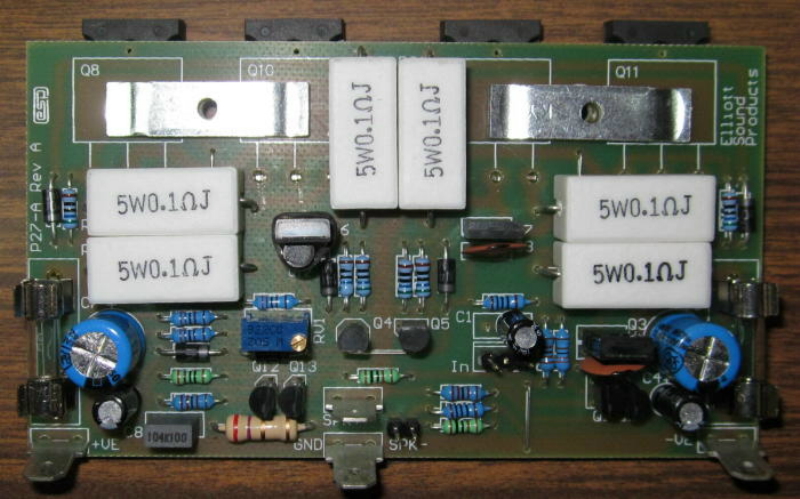
P27A Guitar Power Amplifier Board
Note that while the photo shows 0.1Ω 5W resistors, I strongly recommend that you use 0.22Ω instead. This improves current-sharing for the output transistors, and also improves the current limiting if the output is shorted. Be aware that this is only current limiting, and the amp is not designed to withstand a sustained short circuit.
The power amp (like the previous version) is loosely based on the 60 Watt amp previously published (Project 03/ 3A). Other modifications include the current limiting protection - the two little groups of components including Q4 and Q5. This version is not significantly different from the original, but has adjustable bias, and is designed to provide a 'constant current' (i.e. high impedance) output to the speakers - this is achieved using R23 and R26. Note that with this arrangement, the gain will change depending on the load impedance, with lower impedances giving lower power amp gain. This is not a problem, so may safely be ignored. Note that R16...R19 are shown as 0.22Ω but are 0.1Ω in the photo. A higher resistance improves current sharing. R20 & R21 should be 0.22Ω to allow the current limiters to perform properly.
Should the output be shorted, the constant current output characteristic will provide an initial level of protection, but is not completely foolproof. The short circuit protection will limit the output current to a relatively safe level, but a sustained short will cause the output transistors to fail if the amp is driven hard. The protection is designed not to operate under normal conditions, but will limit the peak output current to about 8.5 Amps. Under these conditions, the internal fuses (or the output transistors) will probably blow if the short is not detected in time. If you use the recommended Speakon connectors (for the amp and speaker), there is little or no chance of a short ever happening. They are isolated from the chassis by design.
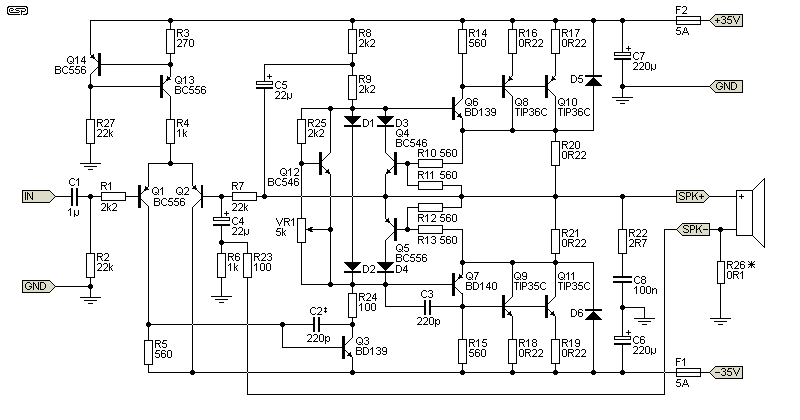
Figure 2 - Power Amplifier (P27A)
Figure 2 shows the power amp PCB components - except for R26 which does not mount on the board. See Figure 1B to see where this should be physically mounted. The bias current is adjustable, and should be set for about 25mA quiescent current (more on this later). The recommendation for power transistors has been changed to higher power devices. This will give improved reliability under sustained heavy usage.
| As shown, the power transistors will have an easy time driving any load down to 4Ω. If you don't use the PCB (or are happy to mount power transistors off the board), you can use TO3 transistors for the output stage. MJ15003/4 transistors are very high power, and will run cooler because of the TO-3 casing (lower thermal resistance). Beware of counterfeits though! There are many other high power transistors that can be used, and the amp is quite tolerant of substitutes (as long as their ratings are at least equal to the devices shown). The PCB can accommodate Toshiba or Motorola 150W flat-pack power transistors with relative ease if you wanted to go that way. TIP3055/2966 or MJE3055/2955 are unsuitable - they can be used for light or 'ordinary' duty, but they aren't recommended at all. |
At the input end (as shown in Figure 1B), there is provision for an auxiliary output, and an input. The latter is switched by the jack, so you can use the 'Out' and 'In' connections for an external effects unit. Alternatively, the input jack can be used to connect an external preamp to the power amp, disconnecting the preamp.
A pair of speaker connections allow up to two 8Ω speaker cabinets (giving 4Ω). Do not use less than 4Ω loads on this amplifier - it is not designed for it, and it will not give reliable service!
All the low value (i.e. 0.1 and/ or 0.22Ω) resistors must be rated at 5W. The 5W resistors will get quite warm, so mount them away from other components. Needless to say, I recommend using the PCB, as this has been designed for optimum performance, and the amp gives a very good account of itself. So good in fact, that it can also be used as a hi-fi amp, and it sounds excellent. If you were to use the amp for hi-fi, the bias current should be increased to 50mA. Ideally, you would use better (faster / more linear) output transistors as well, but even with those specified the amp performs very well indeed. This is largely because they are run at relatively low power, and the non-linearity effects one may expect with only two transistors do not occur because of the parallel output stage.
Make sure that the bias transistor is attached to one of the drivers (the PCB is laid out to make this easy to do). A small quantity of heatsink compound and a cable tie will do the job well. The diodes are there to protect the amp from catastrophic failure should the bias servo be incorrectly wired (or set for maximum current). All diodes should be 1N4004. A heatsink is not needed for any of the driver transistors.
The life of a guitar amp is a hard one, and I suggest that you use the largest heatsink you can afford, since it is very common to have elevated temperatures on stage (mainly due to all the lighting), and this reduces the safety margin that normally applies for domestic equipment. The heatsink should be rated at no more than 0.8°C/ Watt to allow for worst case long term operation at up to 40°C (this is not uncommon on stage).
Make sure that the speaker connectors are isolated from the chassis to keep the integrity of the earth isolation components in the power supply, and to ensure that the high impedance output is maintained. Although phone jacks are the most common for guitar amps, it's better to use XLR or (preferably) Speakon connectors because they can't easily be shorted and are far more rugged. The amp can also be built as a 'combo', with the amp and speaker(s) in the same cabinet. The speakers can be hard-wired for a combo, but a connector is preferred.
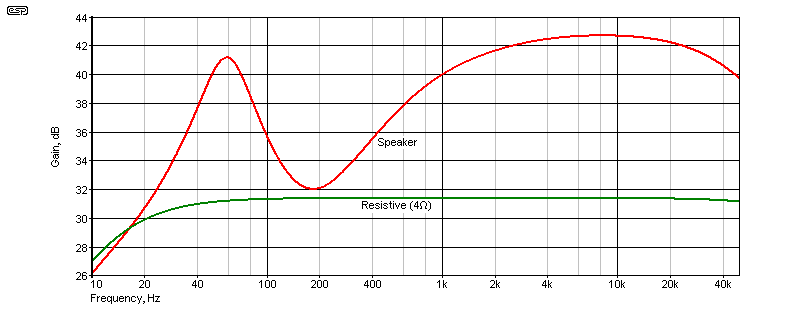
The red trace shows the response into a 'typical' 4Ω loudspeaker (the green trace shows response into a 4Ω resistive load). This is very similar to that from a valve power amp with little or no negative feedback. It looks pretty 'wild', but countless amps (P27A builds and commercial offerings) are the same. The result is an amp that allows the speaker to impart its 'sound' to the overall. If you prefer flat response, omit R23 (100Ω) and R26 (0.1Ω). The gain is then 27dB, 1dB down at 15Hz. You can reduce the output impedance by adjusting the value of R23. A higher value reduces current feedback and reduces the output impedance.
WARNING - Do not attempt construction of the power supply if you do not know how to wire mains equipment.
The power supply is again nice and simple, and does not even use traditional regulators for the preamp (details are on the preamp schematic in Figure 1). The power transformer should be a toroidal for best performance, but a convention tranny will do just fine if you cannot get the toroidal.
 |
Do not use a higher voltage than shown - the amplifier is designed for a maximum loaded supply voltage of +/-35V, and this must not be exceeded. Normal tolerance for mains variations is +/-10%, and this is allowed for. The transformer must be rated for a nominal 25-0-25 volt output, and no more. Less is Ok if the full 100W is not needed. |
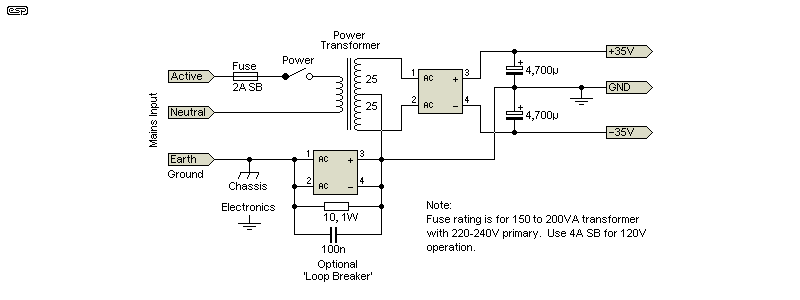
Figure 3 - Power Supply
The transformer rating should be 150VA (3A) minimum - there is no maximum, but the larger sizes start to get seriously expensive. Anything over 250VA is overkill, and will provide no benefit. The slow-blow fuse is needed if a toroidal transformer is used, because these have a much higher 'inrush' current at power-on than a conventional transformer. Note that the 2 Amp rating is for operation from 220 to 240 Volt mains and as shown is suitable for a 200VA transformer - you will need an 4 or 5 Amp fuse here for operation at 115 Volts. Smaller transformers can use a smaller fuse - I am using a 2A slow blow fuse in my prototype (160VA transformer at 240V mains input), which seems to be fine - it allows for a maximum load of 480VA which will never be achieved except under fault conditions.
Use good quality electrolytics (50V rating, preferably 105°C types), since they will also be subjected to the higher than normal temperatures of stage work. The bridge rectifier should be a 35 Amp chassis mount type (mounted on the chassis with thermal compound).
The earth isolation components are designed to prevent hum from interconnected equipment, and provide safety for the guitarist (did I just hear 3,000 drummers asking "Why ??"). The 10Ω resistor stops any earth loop problems (the major cause of hum), and the 100nF capacitor bypasses radio frequencies. The bridge rectifier should be rated at least 5A, and is designed to conduct fault currents. Should a major fault occur (such as the transformer breaking down between primary and secondary), the internal diodes will become short circuited (due to the overload). This type of fault is extremely rare, but it is better to be prepared than not.
Another alternative is to use a pair of high current diodes in parallel (but facing in opposite directions). This will work well, but will probably cost as much (or even more) than the bridge.
All fuses should be as specified - do not be tempted to use a higher rating (e.g. aluminium foil, a nail, or anything else that is not a fuse). Don't laugh, I have seen all of the above used in desperation. The result is that far more damage is done to the equipment than should have been the case, and there is always the added risk of electrocution, fire, or both.

| Please be aware that the above 'earth loop breaker' may be unlawful where you live, and it may cause the guitar amp to fail a PAT (portable appliance tester) test due to the effective resistance in the earth lead (between the circuitry and chassis). It is the responsibility of the constructor to determine whether the (admittedly small) risk is worthwhile, and be aware that 'loop breaker' may cause a PAT test to fail - depending on how the test is applied. The chassis must be connected directly to the incoming earth lead. The loop breaker will only ever become active if there is a short between the primary and secondary of the power transformer. Such failures are very uncommon, and despite my reservations I have included the circuit because such failures are so uncommon. The transformer you use must be a quality unit from a reputable supplier! |
Electrical Safety
Once mains wiring is completed, use heatshrink tubing to ensure that all connections are insulated. Exposed mains wiring is hazardous to your health, and can reduce life expectancy to a matter of a few seconds !
Also, make sure that the mains lead is securely fastened, in a manner acceptable to local regulations. Ensure that the earth lead is longer than the active and neutral, and has some slack. This guarantees that it will be the last lead to break should the mains lead become detached from its restraint. Better still, use an IEC mains connector and a standard IEC mains lead. These are available with integral filters, and in some cases a fuse as well. A detachable mains lead is always more convenient than a fixed type (until your 'roadie' loses the lead, of course. You will never do such a thing yourself  .
.
The mains earth connection should use a separate bolt (do not use a component mounting bolt or screw), and must be very secure. Use washers, a lock washer and two nuts (the second is a locknut) to stop vibration from loosening the connection.
If you do not have a dual output bench power supply
Before power is first applied, temporarily install 22Ω 5W wirewound 'safety' resistors in place of the fuses. Do not connect the load at this time! When power is applied, check that the DC voltage at the output is less than 1V, and measure each supply rail. They may be slightly different, but both should be no less than about 20V. If widely different from the above, check all transistors for heating - if any device is hot, turn off the power immediately, then correct the mistake.
If you do have a suitable bench supply
This is much easier! Do not connect a load at this time. Slowly advance the voltage until you have about +/-20V, watching the supply current. If current suddenly starts to climb rapidly, and voltage stops increasing then something is wrong, otherwise continue with testing. (Note: as the supply voltage is increased, the output voltage will fluctuate initially, then drop to near 0V at a supply voltage of about +/-15V or so. This is normal.)
Once all is well, connect a speaker load and signal source (still with the safety resistors installed), and check that suitable noises (such as music or tone) issue forth - keep the volume low, or the amp will distort badly with the resistors still there if you try to get too much power out of it.
If the amp has passed these tests, remove the safety resistors and re-install the fuses. Disconnect the speaker load, and turn the amp back on. Verify that the DC voltage at the speaker terminal does not exceed 100mV, and perform another 'heat test' on all transistors and resistors.
When you are satisfied that all is well, set the bias current. Connect a multimeter between the collectors of Q10 and Q11 - you are measuring the voltage drop across the two 0.22Ω resistors (R20 and R21). The desired quiescent current is 25mA, so the voltage you measure across the resistors should be set to 5mV +/-2mV. The setting is not overly critical, but at lower currents, there is less dissipation in the output transistors. Current is approximately 5mA / mV, so 5mV gives 25mA.
After the current is set, allow the amp to warm up, and readjust the bias when the temperature stabilises. This may need to be re-checked a couple of times, as the temperature and quiescent current are slightly interdependent. When you are happy with the bias setting, you may seal the trimpot with a dab of nail polish.
 | Note: If R22 gets hot or burns out, the amplifier is oscillating! This is invariably because of poor layout, inadequate (or no) shielding between preamp and power amp, or use of unshielded leads for the amplifier input. Please see the photos of my completed amp to see how it should be laid out. |
Please see Project 27B for the box designs and other useful info. Click here to see photos of the new amp.
This 'Tested: Where Does The Tone Come From In A Guitar Amplifier?' YouTube video may demonstrate to a few people that 'solid state' guitar amps are not the disasters that many valve (vacuum tube) amplifier fanatics may claim. Ultimately, it's about the way the amp distorts and the tonal range available. By experimenting with the tone stack component values, you can get almost any variation you like. The values shown are recommendations, but should be considered a a starting point - constructors should experiment with value changes to get the tone they desire.
 Main Index Main Index
 Projects Index Projects Index |